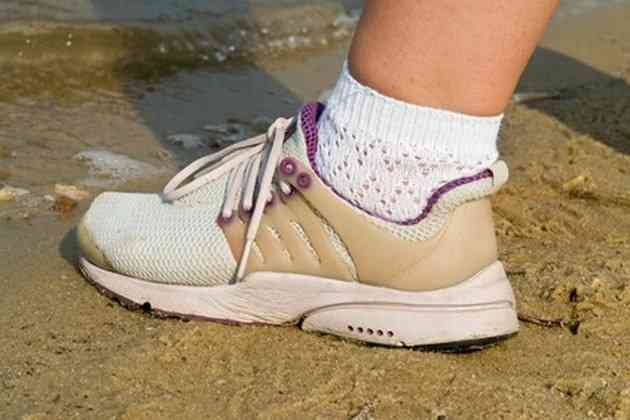Foot Pain When First Walking in the Morning

After sleeping, the muscles of your foot and calf naturally tighten up, which can cause discomfort in the morning. Your foot pain in the morning may also be caused by plantar fasciitis, tendinitis or a stress fracture. Athletes such as runners and dancers -- and overweight individuals -- may be at higher risk of sustaining a foot injury. Treatment includes stretching, ice and anti-inflammatory drugs. Consult your physician about persistent foot pain.
 A close-up of the bottom of a pair of feet peeking out from a blanket on a bed. (Image: anyaberkut/iStock/Getty Images)
A close-up of the bottom of a pair of feet peeking out from a blanket on a bed. (Image: anyaberkut/iStock/Getty Images)Plantar Fasciitis
Your plantar fascia is tissue on the bottom of your foot, which helps support your foot's arches. When your plantar fascia becomes tight and inflamed, it is called plantar fasciitis. Plantar fasciitis is an overuse injury commonly experienced in runners and overweight individuals. Your age, flat feet and wearing shoes with inadequate arch support can increase your risk of plantar fasciitis. Symptoms include pain on the bottom of your foot and heel that is worse in the morning. A 2011 article in the "Journal of Multidisciplinary Healthcare" refers to morning foot pain associated with plantar fasciitis as "first-step pain."
Additional Causes
Arthritis, tendinitis and a stress fracture can also lead to foot pain. Arthritis is the degeneration of the cartilage between the bones of your foot. Degeneration of your tendons like your peroneal and extensor tendons is called tendinitis. A foot stress fracture is when your one of your metatarsal bones partially cracks due to overuse. Joint stiffness and inflammation caused by these injuries can lead to considerable pain while walking early on in the day -- blood flow is decreased to these areas while you are sleeping.
Treatment
To help alleviate pain associated with arthritis, tendinitis and plantar fasciitis, stretch or massage your calf and foot before getting out of bed and walking. For example, sit at the edge of your bed and place your affected foot over a tennis ball. Slowly move your foot over the ball, messaging the bottom of your foot. Icing your foot at night and heating your foot in the morning can further alleviate pain. Treatment for a stress fracture, on the other hand, includes wearing a walking boot or cast and using crutches while walking to promote healing. Additional treatment options your physician may recommend include anti-inflammatory drugs like ibuprofen, a corticosteroid injection and a night splint, which is a boot worn at night. For pain that persists or worsens, physical therapy or surgery may be necessary.
Prevention
To prevent foot injuries and pain, wear appropriate shoes, maintain a healthy weight and avoid over-training. Appropriate footwear includes shoes with plenty of cushion and arch support; this means avoid wearing high heels and flip-flops. Your physician or podiatrist may recommend orthotics to go into your shoes, if you have flat feet or high-arches. Perform stretches before and after exercising and allow plenty of recovery time between workout sessions.




